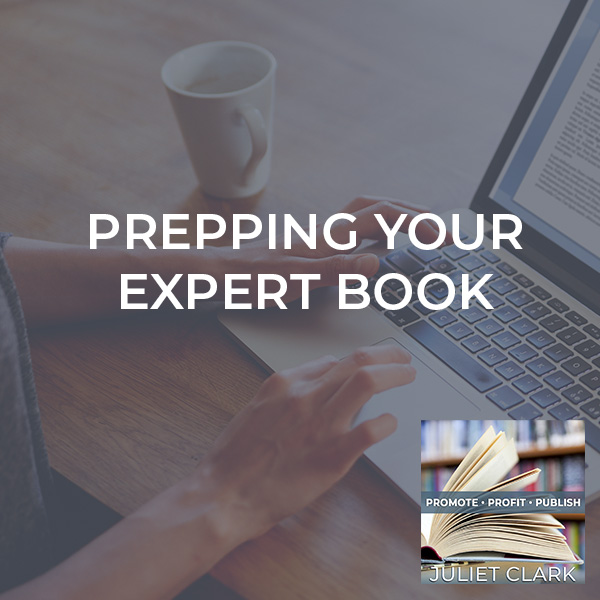
Writers usually have a hard time finishing a book because of too much information running through their heads that they do not know where to start. If you want to write an expert book that will capture everyone’s attention, you need to prepare for it in an expert way. Juliet Clark chats with author Kris Johnson, who developed a simple strategy that can cut writing time in half. She explains how to use colorful cards instead of prepping on a computer screen to sort out the sea of ideas and information flooding your mind. Kris also talks about inviting friends to help you proofread and edit using colored pens.
—
Watch the episode here
Listen to the podcast here
Prepping Your Expert Book
We did a workshop on LinkedIn Live on November 4th. It was with Kris Johnson on prepping your expert book. We talked a little bit about using the same setup for fiction and even presentations. This is the workshop that, if you’re somebody who wants to follow along step by step, you can certainly read it. I would encourage you to go over to Superbrand Publishing and watch the YouTube video. There is a list of things you’ll need to buy. It’s not a big list. It’s just cards and probably things you even have in your home, especially if you have kids because it’s flashcards or the 3×5 cards. I encourage you to go over and take a listen.
Before you head over, don’t forget to get our magazine at www.BreakthroughAuthorMagazine.com, or follow us on LinkedIn and get our podcast delivered to your inbox every week at www.BreakthroughAuthorNewsletter.com. If you go there, it is tagged onto a post. All you have to do is subscribe, and you will start getting that dropped into your inbox every week, as well as invites to the live events we have over on LinkedIn. There’s never any reason to fear jumping on. We normally don’t sell you anything. It’s just information and getting you going on the project of a lifetime. Here’s Kristy.
—
I’m super excited, guys. You guys all know Kris Johnson from our other episode. She’s our book development coach. When I wrote my first book, this is exactly how I did it, although I had no idea that’s how book coaches did it because I was doing it for fiction. I had my office strewn across the floor, and I used to walk over it all the time, which made me keep thinking about it subconsciously. I’d walk across and go, “I don’t like that. I’m going to move that character over here, and this character’s going to do this.” This was super helpful. I hope you guys find it that way too. I want to thank you who reached out and said, “Send us a replay,” and gave us your email. Thank you so much. I will do that once this is processed. We will be making it into a podcast YouTube video as well. Kris, welcome. I’m excited. Take it away.
Thank you. It’s so funny how coincidental it was that you had figured out this little strategy. I figured it out as a ghostwriter, mostly nonfiction. That’s what we’re going to be talking about in this episode. Welcome, everyone. This is the simple strategy that I developed to cut your writing time in half. It seriously cuts your writing time in half. Let’s jump right in and be ready to take notes because this is very interactive. You can implement this strategy now. Here we go. The problem we writers have is that we get in our heads and everything starts spinning around. The reason for that is because we are, in fact, experts in our fields.
We have so much information crammed in here that we think we’re going to write a book. The tendency is to go, “I’m going to just put everything I know in a book.” That’s a mistake. What we want to do is focus on something, get through all the schools of fish in your head that are swimming around confusing you, and just focus on that information. That’s where the strategy helps you. It’s designed to cut through the confusion and give you that time and space to get clear on what you’re talking about and decide how you’re going to do it. This is the confusion side. I know I have been there. I had a client once whom I ghostwrote a book for who was so scattered himself that it took me weeks of interviewing him just to wade through to get clear on what we were going to write the book about.
That was an interesting experience, but it taught me a lot about this thing. This is how I feel. I know some people might feel like the Pink Panther, but we’re going to stop that now. Here’s the key. The key is in the prep. The card strategy that I’m going to teach you is the prep. Instead of trying to prep on a computer screen where you can only see half a page at a time, you’re going to prep in a way where you can see everything. Here we go. If you don’t have paper and a pen and something to take notes with, get it now. It’s very simple. You’ll learn it fast. Just so you know, I used it to write over 30 books as a ghostwriter, which is how I supplemented my teaching career all those years and my own.
I then found out Juliet has used them for fiction. I love coincidence. Now I teach clients like you to organize your own books this way. The last client I had that dedicated herself went from a raw idea to a finished manuscript in five months. That was Sam. She was fantastic. She just took it, ran with it, and it evolved into a beautiful book. These are the supplies that you need to prep your book. This list is all you need. You want to get a pack of white 3×5 cards. It doesn’t matter if they’re lined, rulered, or unrulered. It doesn’t matter. It’s your preference. You’re going to want a pack of the pastels.
The pastels have pretty purple, light yellow, light pink, light green, and light blue. You’re going to want a pack of the neons, the brights. You need a bunch of different colors to organize the strategy. You want to have a Sharpie to write on your cards. I like scotch tape because I learned from Sam to put my cards on the wall because I was putting them on the floor. My cat thinks that means I’m going to play with her. I’d find the book everywhere. Now they go up on the wall. If you have a cat or a dog, you might want to use your wall.
What we’re going to do first is make a color code, which I make a key with the cards and keep it. I put a simple paperclip on it and keep it because I forget what job I assigned to which color. I get mixed up, so I like to have it right in front of me. White is your main point. It also can double as chapter titles. I’m going to show you how to lay it out, but now write down the key. White is your main point and your themes. Your light green, we’re going to assign the job of statistics, graphs, or both. Depending on what book you’re writing, you may not need this. It depends on what you’re doing. This one will be a pretty light usage. People don’t like to be bombarded with a lot of statistics. Maybe a little bit, but not a whole lot.
The light pink, which is one of my favorite ones, is for quotes. Here’s a little tip. Juliet has already told you that she uses the strategy for fiction. Do you know what else you can use it for? Making a speech on a stage. You can use the exact same strategy if you’re going to do a presentation of some kind to help you map it out. I put bits on here if you’re going to tell us to do a bit. It’s some little fun thing in your presentation.
Light purple is if you have a case study. It depends on what book you’re writing if you’re going to use case studies. A lot of top authors, like, for example, Medical Medium, use a ton of case studies in his book. Every case study is directly related to the topic of the chapter that he’s writing. That’s the effectiveness of it because we relate to real people and their results. Light blue is if you have a humorous story. I used to be a teacher. I have many humor stories about things that happen with the kids and/or their parents. I can sprinkle those in and lighten up the tone a lot.
I have a question. Are names changed to protect the innocent?
Absolutely. Always change names. Use a first initial or make up a new name. Always do that. Even if you have permission to use their story in the book, I personally recommend you always change names to protect people. In this state, it’s an important thing.

Expert Book: When writing about children or minors, always change their names even if you have permission to use their stories in your book.
We have a book now that’s going to be out towards the end of January by Gretchen Hydo. It’s Break Free from Your Dirty Little Secret. It’s very funny because there are some things in there that are like, “Thank God she changed the names.”
It’s one thing if the person you wrote about recognizes themself, but as long as you’ve changed the names and protected their identity, you’re going to be okay.
I have to prep you guys. The funniest was, “Used my roommate’s vibrator.” I literally was like, “My gosh.” Moving on, it’s Gretchen Hydo’s Break Free from Your Dirty Little Secret coming in January 2023.
Go, Gretchen. For serious stories, we’re going to use a different color. I use light yellow for serious stories. Those are the ones that are more serious that have more of an impact in that way. Now we’re going to go into the neon colors. I use pink for personal journey. Personal journey can also be a chapter that we usually put at the beginning of how you came to this place and your experience. Sometimes there are little tiny short personal stories that you can tell that you can sprinkle through the book. You’ll want to have a pink card, like where I might write that time that I escaped the serial killer, depending on what book I’m writing, which actually happened. It was an escape. I ran and got away.
Neon green, I use it for tips and tricks. If you’re an expert on anything, you always know little tips and strategies you can share with the clients that you probably already share with your clients that you could put in your book. People love it if you make things simple and easy for them because our world is hard enough without making a book overcomplicated. For neon yellow, I put interactive experiences and exercises. Generally, in a book, they are exercises. You can use these if you’re on a stage, and you can make an interactive experience. It can be as simple as, “We’re going to take this quiz now. Go on your phone. Here’s the quiz link, and take this quiz now.”
If you are an expert on anything, share them with others through your book. People love it when things are made simpler and easier for them. Share on XIt’s interactive for them, and they like it, and then they get to talk about it. That goes well. The last one is your calls to action. That’s the bright orange. You don’t have to put a call to action in every single chapter, but you need to have at least a couple of calls to action. It can be as simple as, “Join my Facebook group. Email me at this email address. Go to my website.” It’s something that they do that helps you build a relationship with your client. Since your book is a huge source of getting to people that don’t know you yet, you want a call to action in there and make yourself really accessible to them.
For the next step, what you’re going to do is use your Sharpie and write on the cards what you’re going to do. I didn’t put in anything specific here. This is an example. What you want to do is put your chapters in vertical columns. I stuck these up on the wall. You see, at the top, there’s a white card. That’s the main point of this chapter. I’m going to show you an example, but I want to show you the overview first. You want to put the main point of the chapter. Sometimes when you write the main point of the chapter, you end up with a great chapter title. They can double. Take what you think. Maybe I want to put a quote first related to my made point, so I’m going to put my light pink card.
When you write the main point of a book chapter, sometimes you will also end up with a great title. Share on XIf I were doing this for real, I would put what quote it is because there are a cajillion quotes out there. I would probably say that quote about imagination by Einstein so I would remember what it is. Like I said, you may want to put a short personal. This is just an example. This isn’t how you have to do it. You will figure out how to do it. I put a short personal journey story that’s also related to the main point. Maybe I have a secondary main point. I have a white card there that’s still related to this main chapter title, but it’s supporting information. You see how I ended with a CTA here.
In the second chapter, I just did this as an example. Maybe I’ll start with a statistic in this one and go to a case study. You see how the colors visually cue you that you’ve got interesting things and that you’re not just speaking nonsense at them. You don’t want to be a talking head on paper. It’s a bad idea. It doesn’t work. You’ll lose your audience. They’ll read a page and be like, “This is boring,” and go on to the next book. This helps you get interest. It also helps you break up what you’re writing and gives you more to work with to focus your idea. I told you I was going to have a real-life sample.
I’m writing a book now called Crack the Homeschool Code. This happened before. I sat down and started thinking. This is my first day of thinking this through, so it’s a brain dump. I made the vertical columns. I put at the top what I wanted to talk about in that chapter. You can see my last one over here. I have what I want to do with it, and I had to stop because I had a client call. I take care of my clients. Anyway, you can see how I’m starting to lay it out. This will evolve as I go along. There are only five chapters in there so far. There’s going to be more, but it’s developing already. What I want you to remember, too, is you don’t have to have all the colors in every chapter. You want to mix it up.
If you’re going to sprinkle in some stats in a chapter, don’t do stats in the next chapter. Mix it up so that the reader doesn’t go, “Ugh.” Mix it up a little bit, so the reader goes with you. I know that there are people who think in a linear way, but most people think in a more creative way as they might eventually get it to be linear. Our minds go around. We’re humans, and we’re creative, so we want to mix stuff up a little bit, especially when you’re playing with developing your book content. You want to have some fun with it. The next step is after you’ve got your first ideas laid out, you do not want to start writing yet. What you want to do is live with it.
Juliet already referred to this when she said, “This character doesn’t do this in this chapter. I’m going to move that card over here.” It is so much easier to move cards than it is to try to find it in a document on your computer where you can only see half a page. Move it to the wall. I’m going to show you what I did. I decided, “I’m going to take this short personal story.” There’s the pink card right here. “I thought it needed to go in this chapter. I’m going to switch that with the case study because that will work better.” You live with it because you know the information.
You don’t need to write every detail on the cards. You already know the information. These cards are just to remind you what you want to talk about in that space. This one here, I added in a tip card. I thought, “What if I give them these statistics with a story and give them a tip that they can directly use now?” You can add cards. You can go, “I repeated myself here. I’m going to take this one out.” You play with it until you get it to where you feel like you’re looking at that board and you’re going, “That’s it.”

Expert Book: You don’t need to write every detail on your cards. You already know the information and are just using them as reminders of what you want to talk about.
Be willing to spend time on prep. Out of the five months that Sam did this, she spent the first two months just on this. When she wrote, she whipped through her chapters. She had it all there, and all she had to do was write it down. She sent it to me, and I edited it for her. That’s what you do. You keep repeating and rearranging until you get all the columns and the chapters the way you want them. You might find you’ve got a chapter that doesn’t fit, like, “I’m talking about X, but this chapter is about Y.” Take it out. You haven’t lost anything because you haven’t written anything yet.
I have a question for you. I used to take this and create my outline. I know we have a lot of people who speak their book. I know myself. I tell a lot of people who say, “I don’t have time to write.” I’ll ask them, “How much time do you spend in the car?” When they tell me, I’ll say, “Why don’t you carry your outline around and record when you’re driving or have some free time because it’s so much easier?” Once you get this done and before you write this prep, it goes into the outline.
Yes, but I’m going to tell people that it is an optional step because I skip it. To me, this is an outline. I know all every card. I know what I want to say, and I take a chapter in the order I put it and start writing. I go, “I want to say this,” flip the card, “This story is this and that.” There are people that need a linear outline. If you’re doing fiction, that outline will benefit you. Honestly, guys, fiction is a lot harder to write.
It is much more detailed. It is much more complicated because you have all the elements of fiction in there. You’ve got to build characters. You have to build a plot. It has to make sense. They have to have depth. The bad guy can’t just be pure evil. There has to be some depth there. There are all these things, and it has to resolve in a satisfactory way. There are all sorts of things that go into fiction, whereas for nonfiction, you don’t have that burden, so it’s a little easier.
Fiction is a lot harder to writer. It is much more detailed and complicated. You have to build characters and a plot that has to make sense. Share on XThe other thing with fiction is that you wouldn’t drive and tell the story because you need the he said she said. You probably wouldn’t speak that, but you would and could with an expert book.
You definitely can with an expert book because you already know what you want to say. The cards are to remind you of what you want to say and where you want to say it, so it makes logical sense to your reader and has a nice flow so that when your reader’s reading it, they’re going, “This is cool. What a story. Next point. This person had this experience. Look at this tip. I’m going to do this now.” You want your readers to do that because when they’re done with your book, they’re fans. You’ve developed a beginning of a relationship with them.
That’s the next thing. When you’re ready, you take a chapter, keep them in the order that you have them, take it off the wall, and write it. I recommend that you go ahead and write it in order, but if you’re working with a book developer like me, you can write them out of order and send them to me, and I can build the manuscript. That’s what I did for Sam. She just sent me a chapter, we talked about it, and we built the manuscript out. She was focused just on the writing, which was good because she wasn’t concerned about all the stuff that came later. Editing is the hard and brutal part, but prep will save you a lot on editing.
Before that, let’s say something that I see a lot. Editing isn’t just, “I’ve done my first draft. I’m sending it to an editor.” You have to rewrite. Sometimes rewrite can be like, “I have to rewrite this?” There are other times you can get a good giggle out of it. I looked at it and gone, “Did I have a major brain fart that day?” You’ll see you misspelled stuff. My thing is pair-pear. I’ll use the wrong version of the word like, “There’s a pear of doves.” I was like, “What the heck was I thinking?”
You have to be really intentional about this just because you got through. I always recommend that you put your prep together and write the whole thing. Don’t micromanage. You’re never going to get your book done if you keep rewriting chapter one. I’ve heard people say, “I’ve been working on this book for five years.” “How much do you have done?” “I’m still in chapter one.” After you’ve done this prep, get that whole book out and start the rewrites. When you’re satisfied with rewrites, send it to the editor.
I have a strategy that people can use that’s simple for the editing part. It’s really easy. One of the things we need once we finish that first draft, which Juliet is right about, is prep it, write the draft, pick 3 to 5 trusted people or trusted friends, but not your mother, and print out a manuscript for each one of them. You give it to them with a red pen and a yellow highlighter. You tell them, “I want you to brutally read this. I want you to criticize everything you don’t like. Don’t hold back.” You have to take your ego out of it and go, “This book has to be good. It’s not about me. It’s about my readers and building my business.”
What they do with the red pen is circle all the typos. When they see pair spelled wrong, they can circle it. They can correct it however they want to do it. The yellow highlighter is for a confusing passage like, “What the heck is this? Why is it in here?” Highlight it. In the margin on the page, write where that yellow highlight is. Write your questions. Do not write your questions at the end because your author won’t know what they’re talking about. Write the question next to the part that’s confusing, “Where did this come from? This doesn’t fit here,” whatever the suggestion is. When you get back your 3 to 5, go through and correct everything.
Here’s the best part. While they’re doing that, you, the author, take a break. When you step back from it and let it go for a little bit, which usually takes about two weeks for people to get back to you, you give yourself your brain a chance to let it work in the back of your mind, and things start clicking in. When you come back to it, you look at it with fresh eyes and go, “Oh,” and your second draft is much easier. That’s the extra strategy you guys got for this episode.

Expert Book: When you step back and let go of your writing for a few weeks and let other people check it for you, your brain will have a chance to work it out in the back of your mind.
Here are a couple of my pro tips. Do not write the chapter numbers on your white cards until after you have finalized your order. If you do that, you have to keep crossing them off. Don’t do that until the end. Do clip your notes together. I use a simple clip to keep my notes together because if you drop them, they go everywhere. If you have a cat like mine, they even go more everywhere. If you guys have any questions, you can always message us through LinkedIn. I’ll be happy to talk to you anytime. If you want to have a one-on-one, message me on LinkedIn, Kristy Boyd Johnson, and I’ll send you my calendar. Same with Juliet. Juliet will do that too.
Next, we have Julie Lokun, who is going to come on and talk to us about some branding and messaging. In January 2023, Mark Herschberg is going to talk to us about brain bumps and walk us through what his new app for authors does. We’ve got some good stuff coming up in the next couple of ones as well as Kris was great in this episode too. Thanks for stopping by. See you.
Important Links
- Kris Johnson
- Superbrand Publishing – YouTube
- www.BreakthroughAuthorMagazine.com
- www.BreakthroughAuthorNewsletter.com
- Medical Medium
About Kris Johnson
 Kristy Boyd Johnson is an award-winning children’s author, and has ghostwritten over 30 books for entrepreneurs over the years. She is a sought-after developmental editor and transformational book coach. She recently launched Starseed Journey Retreats because she can’t imagine anything better than being a beautiful location with beautiful people who want to reconnect with their deepest selves through writing.
Kristy Boyd Johnson is an award-winning children’s author, and has ghostwritten over 30 books for entrepreneurs over the years. She is a sought-after developmental editor and transformational book coach. She recently launched Starseed Journey Retreats because she can’t imagine anything better than being a beautiful location with beautiful people who want to reconnect with their deepest selves through writing.
Love the show? Subscribe, rate, review, and share!









Leave A Comment